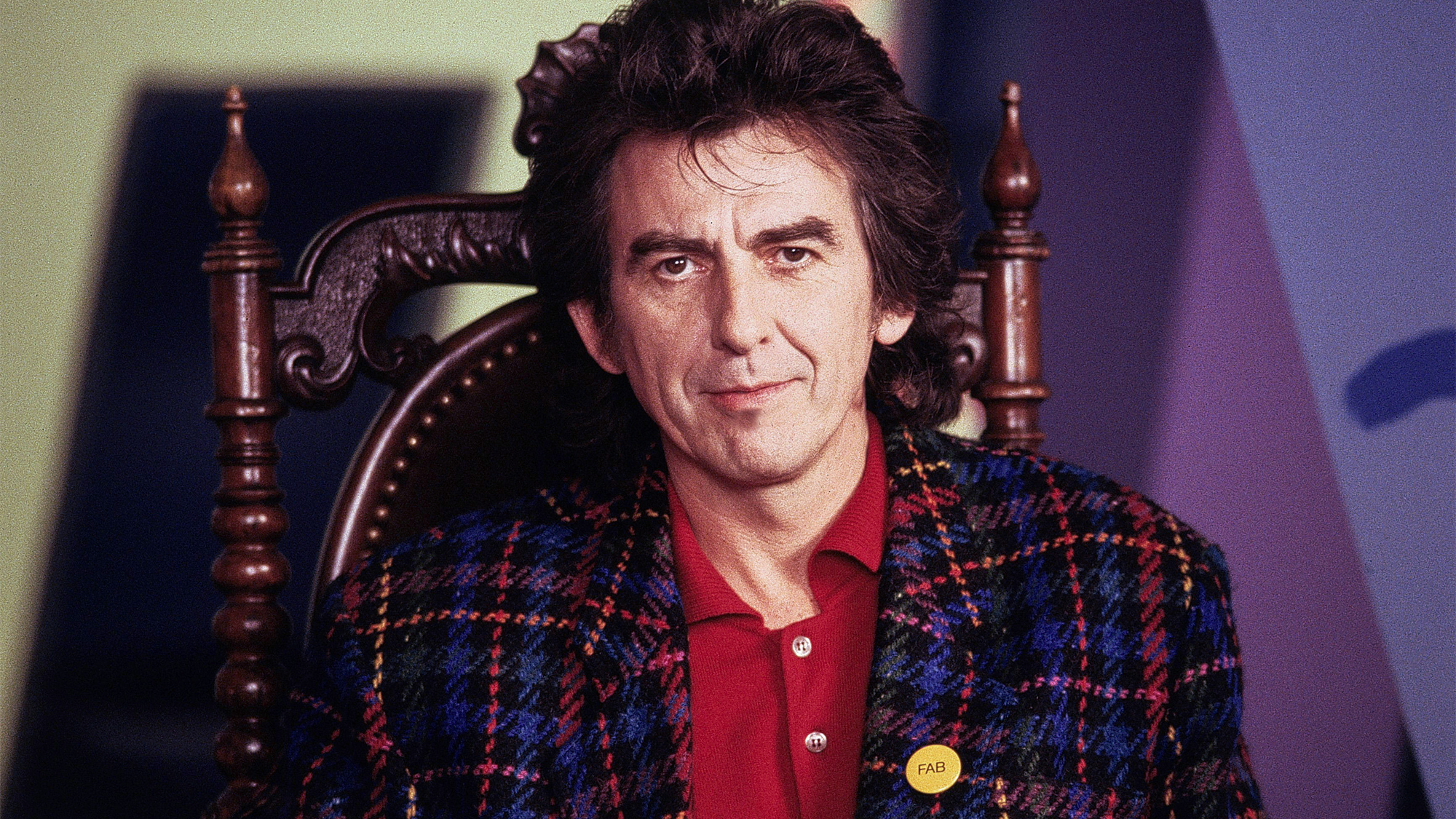Discover and Decode Todd Rundgren’s Unique Chordal Chemistry
Get a behind-the-scenes glimpse into TR’s harmonic architecture
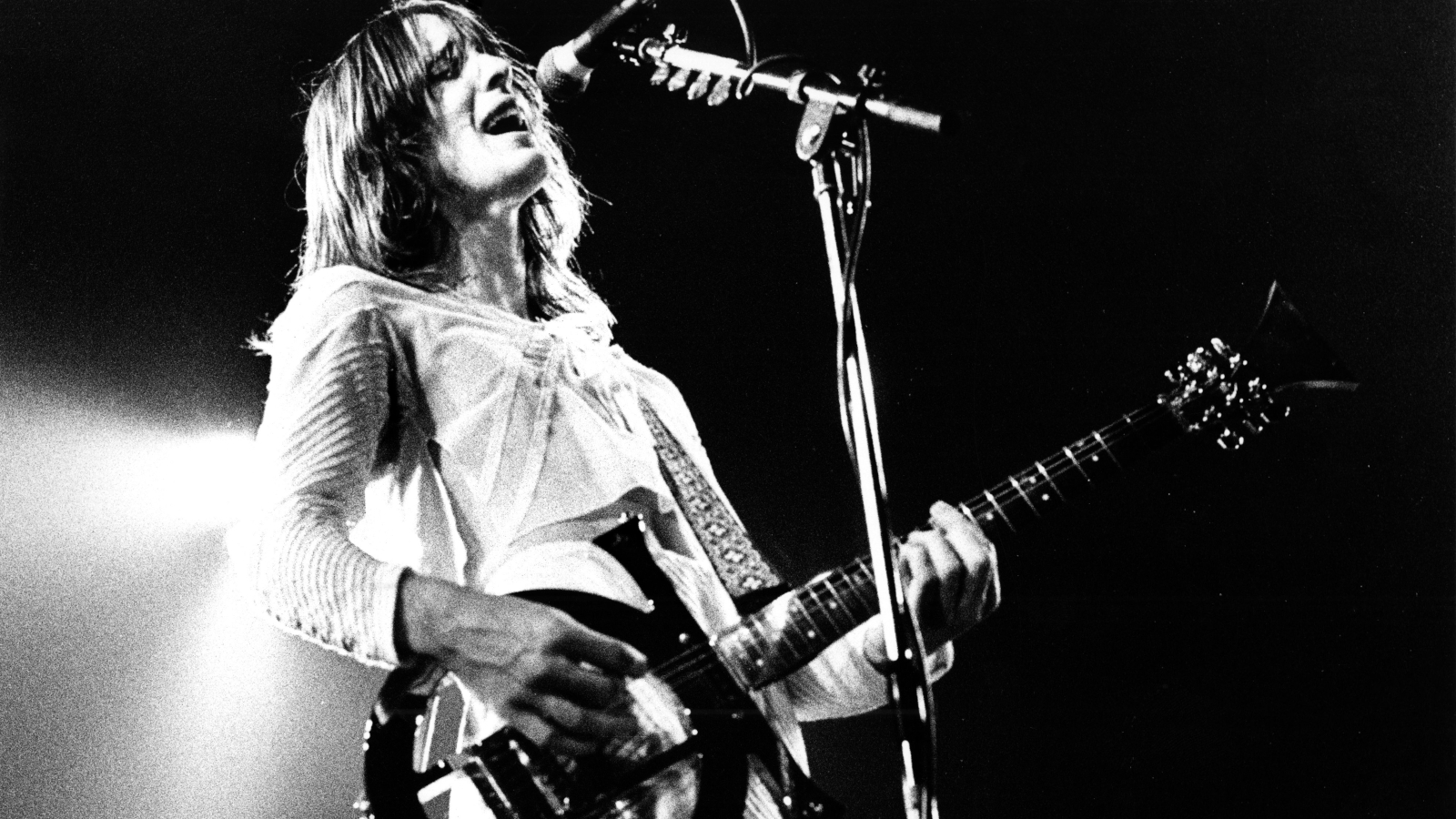
Not many musicians have had their (often single) name indelibly associated with a certain chord. You’ve got Jimi’s seven sharp-nine, Miles’ minor six-nine, George’s seven flat-nine, Donald and Walter’s “Mu” chord and Prince’s funky minor sixes.
And then there’s Todd’s mercurial “T-chord,” so named by many of the musicians who have played and/or recorded with Todd Rundgren – myself included – and marveled at (and been confounded by) this ethereal structure that figures so prominently in his music.
But unlike the other guitarists mentioned, Todd has always had more than one chord up his sleeve, and I’ve spent the better part of the past half-century translating his primarily keyboard-based voicings to the fretboard.
So join me as we dive deep into TR’s harmonic oeuvre and discover the alchemy that makes it tick…
Major and Minor Sevens
Though he certainly didn’t invent major-and minor-seven chords, TR’s command of them became an early hallmark of his composing/songwriting style.
Having discovered them on the white piano keys as root-position inversions in the key of C – he once described the major-seven chord as sounding “so melancholy” – Todd figured out how to transpose them to other keys.
Early on, he often favored the IV-III-II-I progression and used it in many compositions, including his hit “Hello It’s Me,” where it appears in two different keys (F and Bb), as shown in Ex. 1.
All the latest guitar news, interviews, lessons, reviews, deals and more, direct to your inbox!

Slash Chords: Triads Over Bass Notes
The first time I considered any guitar chords as being uniquely Todd’s occurred upon hearing the main guitar figure in “Broke Down and Busted,” the opening cut from his 1970 solo debut, Runt, which is represented in Ex. 2a.
Here we have two parallel root-fifth-root chords, F#5 and G5, both of which are played over an open-A root note to create a root-6-b7-based vamp.
For total authenticity, play through a Uni-Vibe, pick the F#5 and slide into the G5. You can also move G5 up a whole step and add the open high E string to form my favorite TR A5 voicing of all time.

Examples 2b-d expand the previous figure’s harmonic breadth by replacing its parallel root-5 chords with diatonic F#m and G triads (which imply A6 and A9sus4) in three inversions.
Note that the “reversed” fingering that appears on the G/A chord in Ex. 2c (and throughout this lesson) is not a mistake – it’s actually how Todd has always played this common triangular D triad shape…seriously!
Since this is a modal vamp based on two triads (F#m and G) derived from the A Mixolydian mode (A B C# D E F# G), which is the fifth mode of the D major scale (D E F# G A B C#), you can unlock many other TR tonalities by substituting any note from those keys for the given A bass note.

The six grids illustrated in Ex. 3 further this concept by surrounding the previous F#m and G triads with four others that are indigenous to the key of D.
We’ve got Bm (the VI chord), A (the V), G (the IV), F#m (the III), Em (the II) and D (the I). Note how these shapes – which are identical to those on the top three strings of the first six chords in Ex. 1 – also function as upper-structure triads that correlate with the parenthetical major- and minor-seven chord symbols, i.e., Bm/G = Gmaj7, A/F# = F#m7, G/E = Em7, F#m/D = Dmaj7. etc. Try pedaling them over any static bass note from the key of D.

Typical Todd usage includes shifting F#m, Em and G triads over a pedal A bass (à la “Boat on the Charles,” from his 1971 album, The Ballad of Todd Rundgren), as shown in Ex. 4a. Likewise, Ex. 4b features major triads (A and G) sandwiched between minor triads (F#m and Bm), again played over a static A bass note, as employed in two different keys on “King Kong Reggae,” from 1974’s Todd.
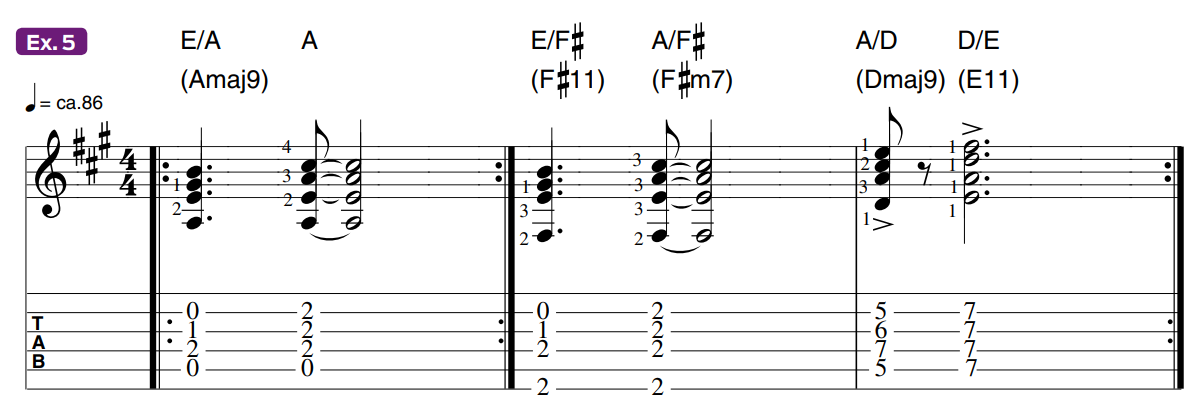
Triads over bass notes became nearly formulaic by the time TR recorded his 1972 opus, Something/Anything?
Ex. 5 outlines the intro slash chords to “It Wouldn’t Have Made Any Difference”: two bars of E/A (a.k.a. a third-less Amaj9) to A, followed by a bar each of E/F# and A/F# (F#11 and F#m7) and A/E and D/E (a third-less Dmaj9 and E11).
Eventually, everyone from Barry White and Fleetwood Mac to Christopher Cross was inspired to jump onto the slash-chord bandwagon.
Utopia Is Here
When Todd formed the first incarnation of Utopia in 1973, the first piece the band recorded was a live version of the “Utopia Theme.”
Part prog-rock homage to the Mahavishnu Orchestra, part extension of TR’s newfound harmonic awareness, the song quite possibly contains the first prototype of the T-chord as played on guitar rather than keyboard.

The song’s main vocal and instrumental theme (Ex. 6) features an unforgettable pickup into a targeted G/F power-slash-chord.
This functions as a Gsus2#4 suspension that resolves to the following G chord, all framing Todd’s sublime “City in my head” lyric in a moment that personifies that signature Lydian Rundgren sound.
Hit the G three times in bar 2, and then follow up in bars 3 and 4 with the uniquely voiced Gsus4 and G resolution (“U-to-pi-a!”).
Birth of the T-Chord
Rundgren’s musical knowledge was informed by contemporary classical (Ravel, Debussy, Satie), pop (Burt Bacharach) and show music (Gilbert & Sullivan, Leonard Bernstein), as well at the work of the Beatles, the Who, the Beach Boys and Laura Nyro.
Together, these influences would lead him to discover the ultimate T-chord on piano by inverting a root-position major-seven chord and eliminating its 3rd.
On the keyboard, this produces a tightly clustered “doggie chord,” named for the fact that TR uses neither middle finger when playing keyboards, giving his hand the shape of a four-legged animal. On guitar, however, it translates to a five-fret-stretch “giraffe chord.”
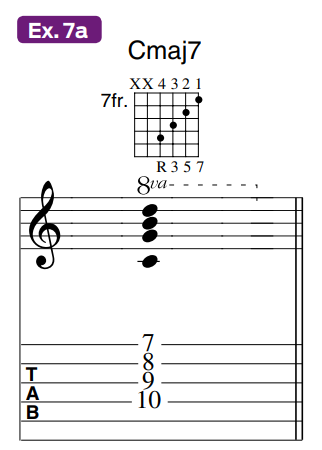
Ex. 7a diagrams the aforementioned root-position Cmaj7, which is converted in bar 1 of Ex. 7b to the wonderfully discordant three-note T-chord cluster.
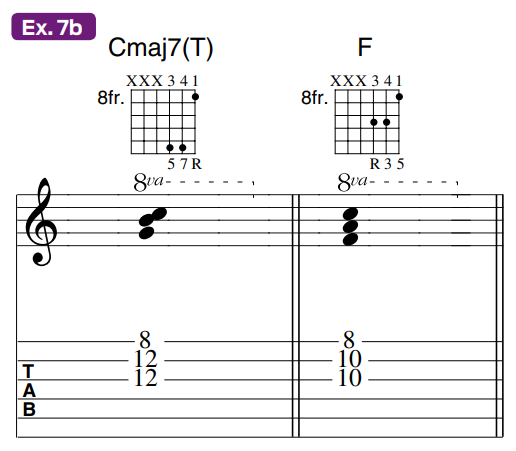
(Feeling ambitious? Transfer the same voicing to the next lower string group and formulate the 7-root-5 and 5-root-7 inversions on both string groups.)
“What is that thing called?” has always been a common but not easily answered query among TR’s collaborative musicians.
As it turns out, the answer is entirely dependent on the bass note of the moment. The chord – say Cmaj7(T) – functions differently when rooted over each note of its parent C major scale.
The complex chords and modal shifts that result are as follows: Cmaj7(T)/C = Cmaj7 (Ionian); Cmaj7(T)/D = D13sus4 (Dorian); Cmaj7(T)/E = Em (add#5/b13) (Phrygian); Cmaj7(T)/F = Fsus2/#4 (Lydian – this is likely the most recognized version of the T-chord); Cmaj7(T)/G = Gadd4 (Mixolydian); Cmaj7(T)/A = Am9 (Aeolian); and Cmaj7(T)/B = Cmaj7 (7 in bass, Locrian).
Two-chord modal vamps over any diatonic bass note can be created by following Cmaj7(T) with the F triad voicing shown in bar 2. (Notice how the top voice remains the same while the bottom two notes drop a whole step.)
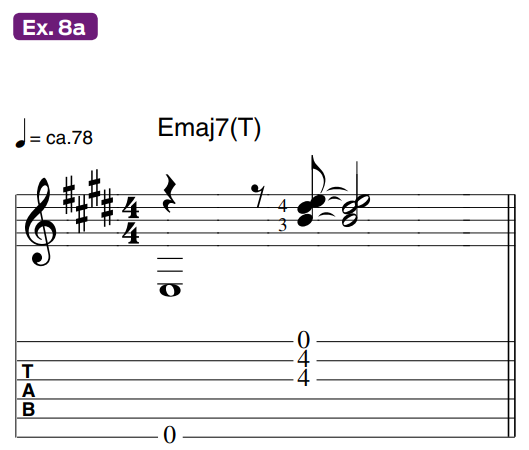
Ex. 8a transposes Cmaj7(T) down four whole steps to Emaj7(T) to facilitate the use of open strings, and assigns an alternating-bass-and-chord rhythmic motif.
This forms the basis for TR’s first major foray into making T-chords the foundation of an entire song, namely “The Spark of Life,” the opening cut from Todd.
I’ve also transposed it down a half step from its original key to render the chords in a more guitar-friendly fashion.
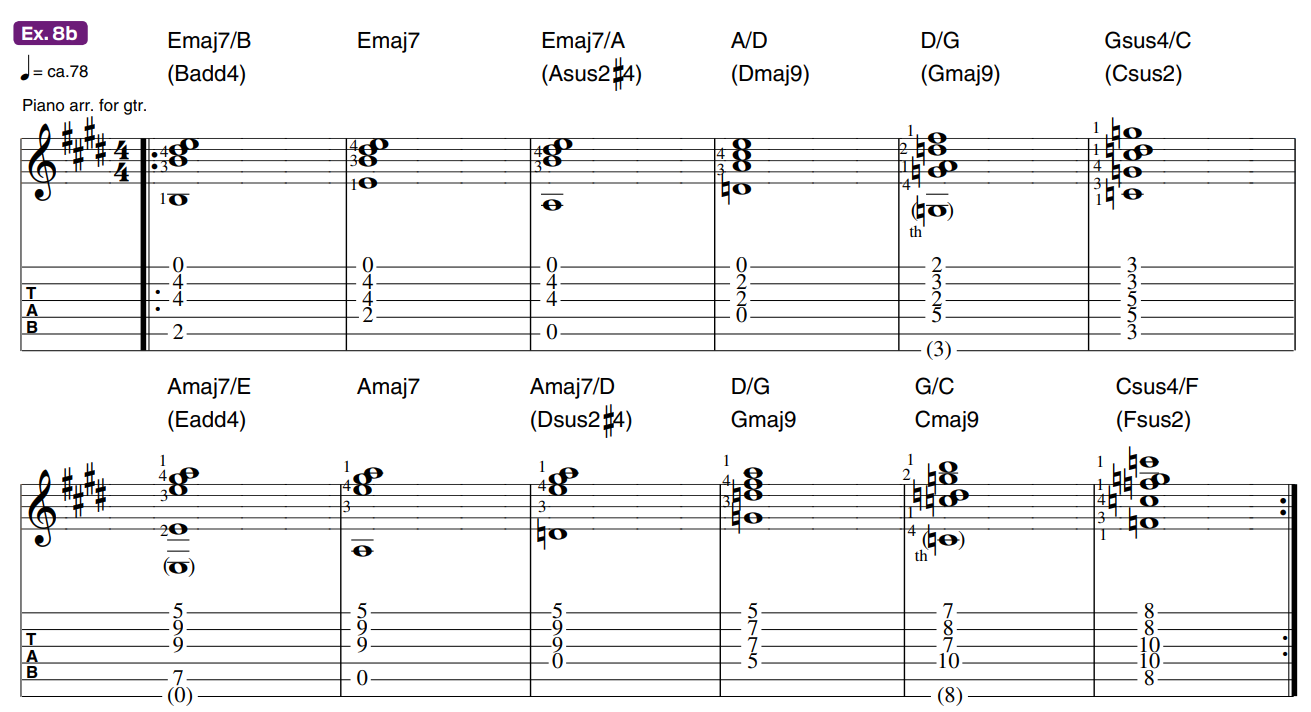
Assign the same bass-chord rhythm to each measure of Ex. 8b, which outlines the song’s repetitive 12-bar progression.
The play-by-play reveals three bars of an Emaj7(T) chord played over B (the 5), E (the root) and A (the 4), respectively, creating a dense, luscious Badd4-Emaj7-Asus2#4 movement.
Bar 4 drops the T-chord’s bottom two notes a whole step over a D bass note to form A/D (a.k.a. Dmaj9), while bar 5 transposes and revoices the chord as D/G, or Gmaj9.
The six-chord cycle concludes with Gsus4/C (Csus2) before it is repeated verbatim, albeit transposed up a perfect fourth (two-and-a-half steps).
Savor the beautiful dissonances created by those half-step “rubs.”
Guit-TR Chords
When a T-chord appears on guitar, as it often does, it is usually in the guise of a major triad with its b7 in the bass.
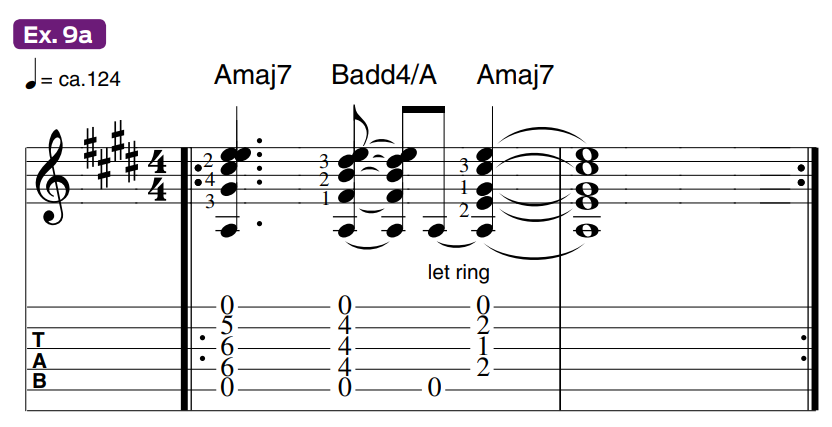
Ex. 9a shows Badd4/A sandwiched between two different Amaj7 voicings, all embellished with open high E notes, à la “Love of the Common Man,” from 1976’s Faithful.
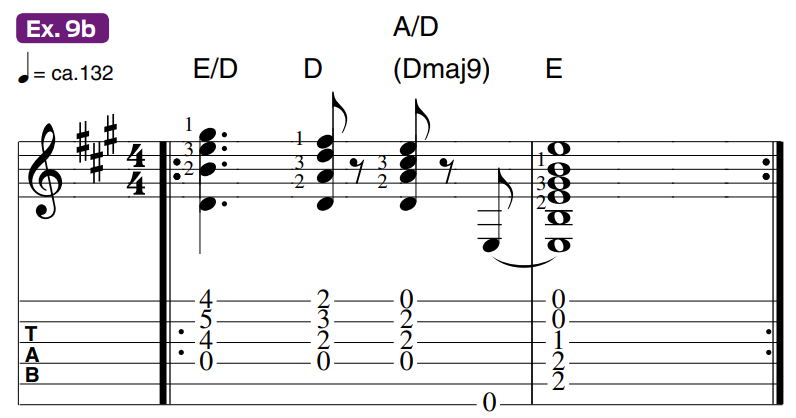
Ex. 9b presents a straight-ahead E/D-D-A/D-E power-pop slash-chord riff gleaned from “Lysistrata,” off Utopia’s 1982 release, Swing to the Right.

Ex. 10 is less rock-oriented. Here, the T-chord (Fsus2#4, or Gadd4/F) is transferred to the next lower string group and played in a bossa nova ballad context.
We’re in the key of A minor, so the opening F is functioning as the bVI chord, while the Fsus2#4 serves as a suspended V chord bridge to the tonic Am.
I used this figure as the basis for my nylon-string accompaniment while recording the song “Fidelity,” for TR’s 1997 album With a Twist….
Compassionate Chords
The next 25 grids provide nearly everything you need to play the chorus figures in Todd’s gorgeous ballad “Compassion” (from 1981’s Healing), a self-contained textbook study in slash chords and upper-structure triads in all three inversions (as well as suspensions, which we’ll come to soon).
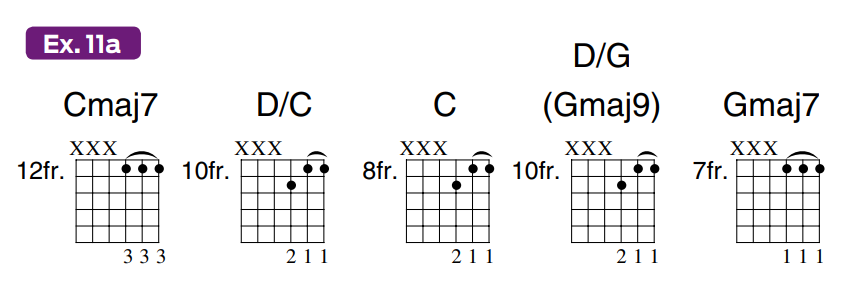
Ex. 11a diagrams the five upper-structure triads (Em-D-C-D-Bm) used to define the song’s four-bar Cmaj7-Gmaj7-based progression.
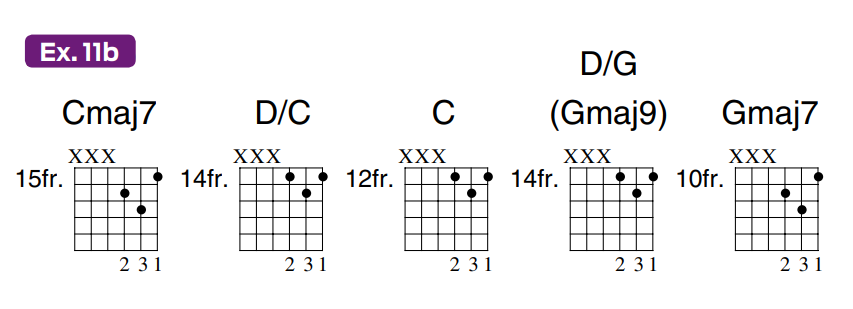

As the extended outro chorus progresses, the same chords are inverted up the fretboard, first to the ones shown in Ex. 11b and then to the really high two-note inversions in Ex. 11c.

Ex. 11d transposes Ex. 11b’s voicings down an octave and transfers them to the next lower string group.

Finally, Ex. 11e adds bass notes to Ex. 11d to form the complete harmonic picture.
Now, graft any of the previous sets of voicings to either four-bar rhythm figure depicted in Examples 12 and 12b, and away you go!

Sussy Galore
Complex and compound suspensions loom large throughout the Rundgren catalog, and our final three examples bear this out.

Ex. 13 essentially picks up where the previous “Compassion” examples left off. Bar 1 consists of broken Baug, Eb and Bbsus4 triads played over a C-F-F bass line, followed in bar 2 by full Bbsus4, Bb and Bbmaj7 chords, all played over a Bb bass.
Bar 3 features a broken Am7 chord and shift to D6 over A-to-D bass motion before the same D6 is recast as Gmaj7 and arpeggiated along with the previous Am7 in bar 4.
The final Bm7 leads back to Ex. 11a–11e’s multiple-choice chorus rhythm figures.

Ex. 14’s churchy-sounding suspensions (from Global’s “Soothe”) come courtesy of Fadd9/C-F/C, a TR favorite, found in numerous songs, including “Sons of 1984” and Utopia’s “Bad Little Actress”; they’re followed by Csus4-C and a resolution to G/B.
The hammered C/E triad and G/D in bar 2 provide a pickup to the repeat of the same figure. It’s a remarkably clever take on the timeworn F-C-G progression.

We’ll wrap up with Ex. 15’s set of beautifully voiced compound suspensions that provides the perfect ending for both “Too Far Gone” (from 1978’s Hermit of Mink Hollow) and this lesson. (Tip: To get the full effect, you’ll need to pre-record those bass notes or get someone to play them.)
This is just a behind-the-scenes glimpse into TR’s harmonic architecture, which typically comes first in his composing process.
It doesn’t take into account the genius of the melodies, lyrics and arrangements he crafts in his songs. To unlock those, you’ll have to listen, listen and then listen some more, just as I still do!
Thanks, Todd!
